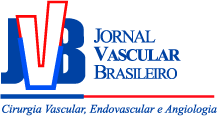Inibição da expressão de ciclooxigenase 2 em feridas cutâneas de camundongos NOD submetidos à terapia a laser de baixa intensidade
Inhibition of cyclooxygenase 2 expression in NOD mice cutaneous wound by low-level laser therapy
Carolina de Lourdes Julião Vieira Rocha; Adeir Moreira Rocha Júnior; Beatriz Julião Vieira Aarestrup; Fernando Monteiro Aarestrup
Resumo
Palavras-chave
Abstract
Keywords
References
Carvalho CBM, Motta Neto , Aragão LP, Oliveira MM, Nogueira MB, Forti AC. Pé diabético: análise bacteriológica de 141 casos. Arq Bras Endocrinol Metabol. 2004;48(3):398-405.
Milech A, Oliveira JEP. Diabetes mellitus: clínica, diagnóstico, tratamento multidisciplinar. 2004.
Economic consequences of diabetes mellitus in the U.S in 1997. Diabetes Care. 1998;21(2):296-309.
Margolis DJ, Berlin JA, Strom BL. Risk factors associated with the failure of a venous leg ulcer to heal. Arch Dermatol. 1999;135(8):920-6.
Fernandes ARC, Peçanha PC, Turrini E, Natour J. Avaliação por imagem do pé diabético. Rev Bras Reumatol. 2001;41(5):305-8.
Rocha Júnior AM, Vieira BJ, Andrade LC, Aarestrup FM. Low-level laser therapy increases transforming growth factor-β2 expression and induces apoptosis of epithelial cells during the tissue repair process. Photomed Laser Surg. 2009;27(2):303-7.
Viegas VNO, Abreu ME, Viezzer C. Effect of low-level laser therapy on inflammatory reactions during wound healing: comparision with meloxicam. Photomed Laser Surg. 2007;25(6):467-73.
Rocha Júnior AM, Oliveira RG, Farias RE, Andrade LCF, Aarestrup FM. Modulation of fibroblast proliferation and inflammatory response by low-intensity laser therapy in tissue repair process. An Bras Dermatol. 2006;81(2):150-6.
Weis LC, Arieta A, Souza J, Guirro R. Utilização do laser de baixa potência nas clínicas de fisioterapia de Piracicaba, SP. Fisioter Bras. 2005;6(2):124-9.
Buschard K, Hanspers K, Fredman P, Reich EP. Treatment with sulfatide or its precursor, galactosylceramide, prevents diabetes in NOD mice. Autoimmunity. 2001;34(1):9-17.
Leiter EH, von Herrath M. Animal models have little to teach us about type 1 diabetes: 2. In opposition to this proposal. Diabetologia. 2004;47:1657-60.
Homo-Delarche F. Is pancreas development abnormal in the non-obese diabetic mouse, a spontaneous model of type I diabetes?. Braz J Med Biol Res. 2001;34:437-47.
Atkinson MA, Leiter EH. The NOD mouse model of type 1 diabetes: as good as it gets?. Nat Med. 1999;5(6):601-4.
Baliga RS, Chaves AA, Jing L, Ayers LW, Bauer JA. AIDS-related vasculopaty: evidence for oxidative and inflammatory pathways murine and human AIDS. Am J Physiol Heart Circ Pysiol. 2005;289(4):H1373-80.
Suschek CV, Schnorr O, Kolb-Bachofen V. The role of iNOS in chronic inflammatory process in vivo: is it damage-promoting, protective, or active at all?. Curr Mol Med. 2004;4(7):763-75.
Batista AC, Silva TA, Chun JH, Lara VS. Nitric oxide synthesis and severity of human periodontal disease. Oral Dis. 2002;8(5):254-60.
Bezerra MM, Lima V, Alencar VB. Selective cyclooxigenase-2 inhibition prevents alveolar bone loss in experimental periodontitis in rats. J Periodontol. 2000;71(6):1009-14.
Boulton AJM. The diabetic foot: an update. Foot Ankle Surg. 2008;14(3):120-4.
Wu SC, Jensen JL, Weber AK, Robinson DE, Armstrong DG. Use of pressure offloading devices in diabetic foot ulcers: do we practice what we preach?. Diabetes Care. 2008;31(11):2118-9.
Chen MC, Lee SS, Hsieh YL, Wu SJ, Lai CS, Lin SD. Influencing factors of outcome after lower-limb amputation: a five-year review in a plastic surgical department. Ann Plast Surg. 2008;61(3):314-8.
Lincoln NOB, Radford KA, Game FL, Jeffcoate WJ. Education for secundary prevention of foot ulcers in people with diabetes: a randomised controlled trial. Diabetologia. 2008;51(11):1954-61.
Gardner SE, Frantz RA. Wound bioburden and infection-related complications in diabetic foot ulcers. Biol Res Nurs. 2008;10(1):44-53.
Rocha Júnior AM, Vieira BJ, Andrade LCF, Aarestrup FM. Effects of the low-level laser therapy on the evolution of the wound healing in human: the contribution of in vitro and in vivo experimental studies. J Vasc Bras. 2007;6(3):258-66.
Singer AJ, Clark RA. Cutaneous wound healing. N Engl J Med. 1999;341(10):738-46.
Thomas DW, O'Neill ID, Harding KG, Shepherd JP. Cutaneous wound healing: a current perspective. J Oral Maxilofac Surg. 1995;53(4):442-7.
Murphy MO, Ghosh J, Fulford P. Expression of growth factors and growth factor receptor in non-healing and healing ischaemic ulceration. Eur J Vasc Endovasc Surg. 2006;31(5):516-22.
Leung MC, Lo SC, Siu FK, So KF. Treatment of experimentally induced transient cerebral ischemia with low energy inhibits nitric oxide synthase activity and un-regulates the expression of transforming growth factor-beta 1. Lasers Surg Med. 2002;31(4):283-8.
Wu XY, Yang YM, Guo H, Chang Y. The role of connective tissue growth factor, transforming growth factor beta 1 and Smad signaling pathway in cornea wound healing. Chin Med J (Engl). 2006;119(1):57-62.
Cipollone F, Fazia M, Mincione G. Increased expression of transforming growth factor-β 1 as a stabilizing factor in human atherosclerotic plaques. Stroke. 2004;35(10):2253-7.
Ihn H. Pathogenesis of fibrosis: role of TGF-beta and CTGF. Curr Opin Rheumatol. 2002;14(6):681-5.
Maier P, Broszinski A, Heizmann U, Boehringer D, Reinhard T. Determination of active TGF-beta2 in aqueous humor prior to and following cryopreservation. Mol Vis. 2006;12:1477-82.
Yasuda K, Aoshiba K, Nagai A. Transforming growth factor-beta promotes fibroblast apoptosis induced by H2O2. Exp Lung Res. 2003;29(3):123-34.
Bernasconi P, Torchiana E, Confalonieri P. Expression of TGF-beta 1 in dystrophic patient muscles correlates with fibrosis: Pathogenetic role of a fibrogenic cytokine. J Clin Invest. 1995;96(2):1137-44.
Salvemini D. Regulation of cyclooxigenase enzymes by nitric oxide. Cell Mol Life Sci. 1997;53(7):576-82.
Lohinai Z, Stachlewitz R, Székely AD, Fehér E, Dézsi L, Szabó C. Evidence for the expression of cyclooxigenase-2 enzyme in periodontitis. Life Sci. 2001;70(3):279-90.
Rabelo SB, Villaverde AB, Nicolau R, Salgado MC, Melo MS, Pacheco MT. Comparison between wound healing in induced diabetic and nondiabetic rats after low-level laser therapy. Photomed Laser Surg. 2006;24(4):474-9.
Byrnes KR, Barna L, Chenault VM. Photobiomodulation improves cutaneous wound healing in an animal model of type II diabetes. Photomed Laser Surg. 2004;22(4):281-90.
Demir H, Balay H, Kirnap MA. A comparative study of the effects of electrical stimulation and laser treatment on experimental wound healing in rats. J Rehabil Res Dev. 2004;41(2):147-54.

